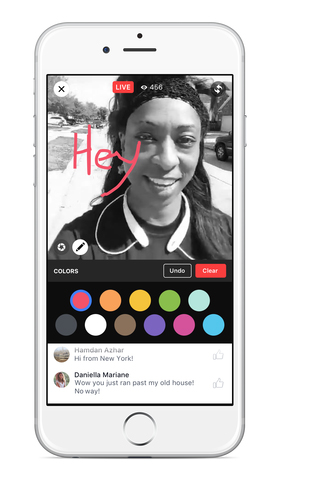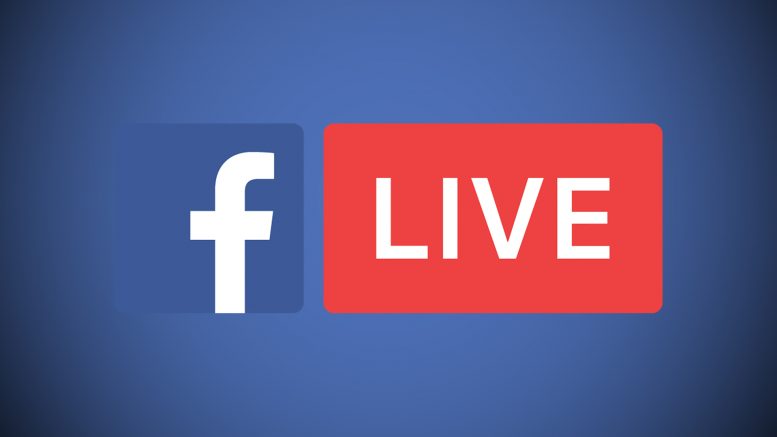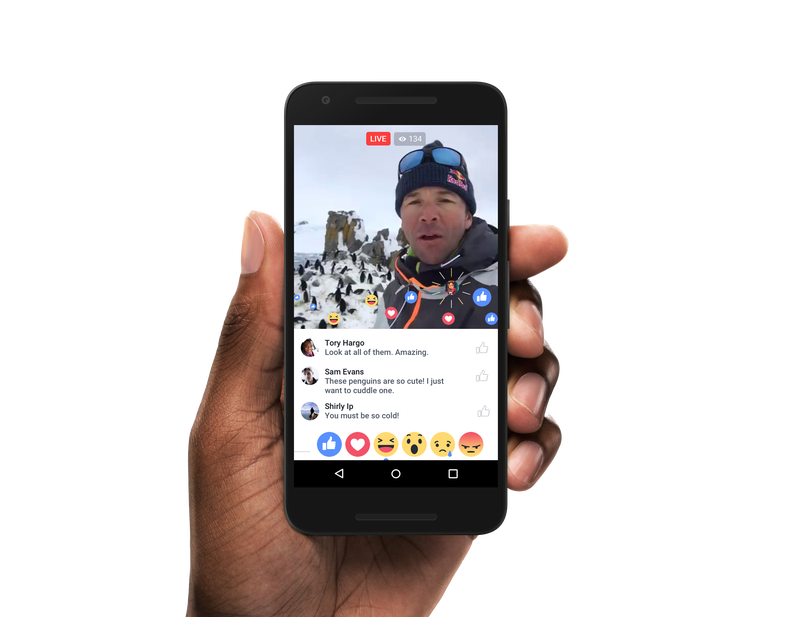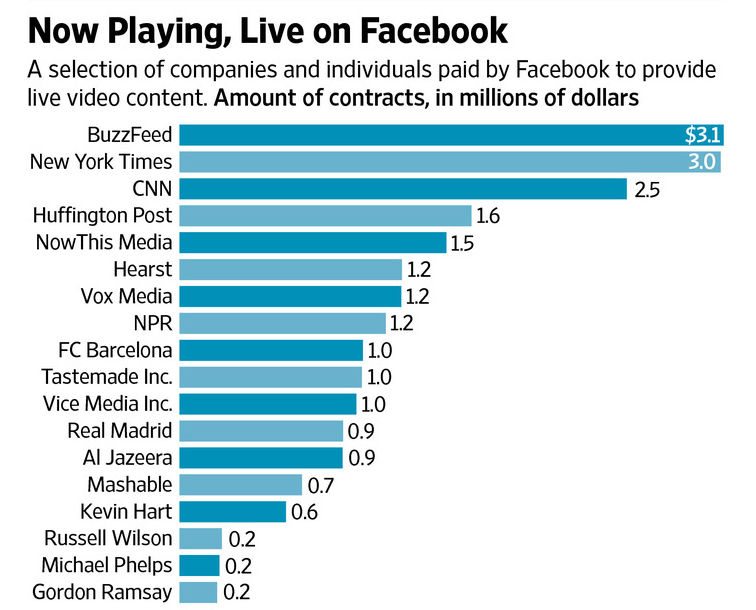1. What is Facebook live?
“Broadcast to the largest audience in the world with the camera in your pocket.”
Facebook Live is a Facebook feature that allows all users to film themselves in real time and share it to their followers. This feature allows for instant connection and has an interactive aspect since viewers can comment during the broadcasting.
2. History
Facebook noticed that people were sharing live video a lot more compared to links and other video formats. On average, people were watching live streams longer and commenting a lot more than on regular video content.
The initial release of Facebook live was on August the 5th 2015. At the beginning Facebook live was launched with limited basis to celebrities with a verified facebook page. Facebook live should be an exciting and authentic possibility to connect with a public figure on a real-time basis. On the 6th of April 2016 Facebook live was launched for everyone „to make it easier to creat, share and discover live videos“.
With Live, Facebook had an instantly valuable product. The videos were exclusive because users had to access the platform to create them. Since streams were live, the content was timely. And there was also an inherent interactivity to them, since people could comment as they watched.
Facebook also paid approximately 140 publishers and influencers a combined $50 million to start creating video for Live. The following companies and persons were paid to creat live video content:
3. Competitors
Facebook Live has numerous competitors: on social media level Snapchat is one of them with the feature „live stories“ where users can add their Snapchat picture or video to a public story of a very important football match, for instance. That´s not exactly live streaming but it also features live video components.
Another social media network that offers the possibility to stream live with a smartphone is Instagram. Instagram Live has similar features to Facebook Live, e.g. commenting on a live stream but there are also differences: one big difference to Facebook Live is that the streams on Instagram can not be watched afterwards, so if you miss a stream from your favorite celebrity, it´s gone and you will never have the chance to see it.
Two of the biggest streaming platforms that aren´t social media networks, are YouTube and Twitch. There, streaming is a popular feature, especially for Gamers and Let´sPlayers, so they can play a video game and their followers can watch and comment. Many Youtubers also upload their streams, or at least the highlights, as a video afterwards, so that followers who missed the stream, can also watch it.
Other live streaming apps are Periscope, Alively and Meerkat, which was already shut down.
4. Live Video Example
Chewbacca Mom ist the most watches video with 170,519,825 views. Look at it!
It's the simple joys in life….
Posted by Candace Payne on Donnerstag, 19. Mai 2016
5. Current Features
Go live from the web: go live from the web enables users to go live from their computers with a webcam, so that they don´t have to use their smartphone where the video often gets shaky. It´s more comfortable to go live from the computer.
Live Contributor for pages: until recently, only the owners of pages had the possibility to start a live stream but that changed with the „Live Contributor“ role which can be given to users. Live contributors can start live streams but don´t have access to all informations and functions of the page. That gives journalists, for example, the chance to start a live stream very spontaneously when a terroristic attack or something similar happens.
Live comment pinning: live comment pinning gives the streamer the opportunity to pin comments he/ she likes the most or finds the most interesting. Pinned comments will appear at the top of the comment section.

Stream with friends: stream with friends is a feature which is not fully included yet, only a few verified accounts already have access to it. It shall give streamers the opportunity to stream together with a friend. Therefore two smartphones are needed, but no special equipment is required.
Filters: filters in Facebook live have the same function as they do in snapchat. A streamer can put a filter over his face to make the stream more funny and entertaining. Filters can be seen as nice shenanigans.
Waiting rooms: in the past, users were notificated about a stream as recently as it started, what was kind of problematic because it took a bit of time until a big audience watched the streams. The waiting rooms work like an event in Facebook to announce streams days or weeks ahead.
6. Advantages
Easy to use: Facebook Live is affordable and easy to use. it’s up to the streamer to use high quality broadcast equipment but in general just a mobile phone will suffice. This makes it easy for the smallest businesses to make use of the opportunity. Since it is integrated in Facebook no separate app must be downloaded.
Marketing: Facebook live can be used as an innovative marketing tool. It’s a great opportunity for companies to show what goes on behind the scenes, the launch of a new product, who works there or to answer questions from followers and build a customer relationship with immediate feedback.
Exposure: The longer you stream the more likely it is for you to be discovered, to get lots of exposure and to be shared on Facebook. A live stream can be started without any prior requirements like adverts or an announcement.
Subscribe: It’s possible to subscribe a Facebook page and to opt in to receive a notification when a page/another user starts a new stream and give feedback in real time. The video also remains on the Facebook feed even after the end of the streaming session. This allows marketing to use the video for other communication channels and campaigns such as a newsletter or an advert.
Statistics: Another benefit are the statistics Facebook offers. Metrics are showing the peak viewing times which helps you with your quality management.
7. Disadvantages
Scheduling with a global audience: if your goal is to increase engagement with your content you might have to resort to several live streams a day to catch the audience at the right time. This costs you time.
Unpredictability: in real time anything can happen such as slips of the tongue, problems with your equipment or other major and minor mishaps. You can always delete the content off your page but in some cases the damage is already done since users react in real time. Technical problems that are Facebook’s fault like glitches, blurry video or murky audio can happen and may cost you subscribers.
Target group: If your target group is in a certain age range (teens, young adults) they might show more interest in other platforms like for example Snapchat for video content.
infringement of a right: you always have to be careful not to infringe somebody’s rights. This could cause an argument – in particular a company infringed the right.
8. Regulations
The regulations for live streams on Facebook are the same as for normal videos and pictures on the platform: violent, graphic or otherwise forbidden contents aren´t allowed to show in live streams, but there needs to be differentiation: if a person witnesses a crime, for example a shooting in a school, and uses Facebook Live to raise awareness for the crime, so that it gets shared and the police gets alarmed, it´s allowed. But if someone shares that stream to mock the victims or celebrate the shooting, the video would be taken down.
Any user can report a video or a live stream, whereas only one report is needed for a video or stream to be reviewed, because Facebook relies on its users as well as a team of moderators to remove forbidden content as soon as possible. Also, algorithms to push possibly forbidden content to the front of the moderation queue, are being developed.
Static or looping images and polls with unmoving images are also forbidden on Facebook Live.
9. Facebook Live & Publishers
Facebook Live offers many opportunities for the publishing industry. Publishing houses could give their followers insights into the work of publishers by streaming editorial meetings, for example.
Interviews or readings with authors also lend themselves to be streamed live as the followers can post their questions into the comment section whereon the author can answer them straight away. Facebook Live also provides a useful feature when it comes to live press coverage as events like important football matches, concerts or even natural catastrophes can be reported on right after it happened to operate the curiosity of the people.
Publishing houses could also do live polls on Facebook Live where the followers can vote for the cover of a coming book, for example. The advantages are that the editor can communicate directly with the followers and it´s possible to instantly react on wishes, questions and so on. Disadvantages could be that the editor has to be very well prepared to do a live stream and that some topics have a high discussion level, like the cover of a new book.
The resulting chances for publishers are on the hand that they can build up a relationship between them and their readers by reaching them on a new level and on the other hand reaching new audiences and acquiring new followers by appearing as a sponsored stream on the timelines of users who haven´t liked their page yet.
10. Future Plans
Monetization: This feature is already being tested. Live video ads can be as long as 15 seconds and are available to pages or profiles in the United States with at least 2.000 followers and 300 or more concurrent viewers in a live video. The first ad break can occur after 4 minutes of broadcasting and additional ones are allowed 5 minutes after the last ad break.
Facebook already pays different partners for live streaming and they plan to continue doing that in the future. Facebook also plans to invest in exclusive entertainment content to stream on the platform. Another feature which is already being tested is pushing live videos in the form of sponsored posts so they appear on timelines of users who aren´t even followers of the page.
by Hanna Sorensen, Laura Diemand, Lucca Reder und Luisa König



